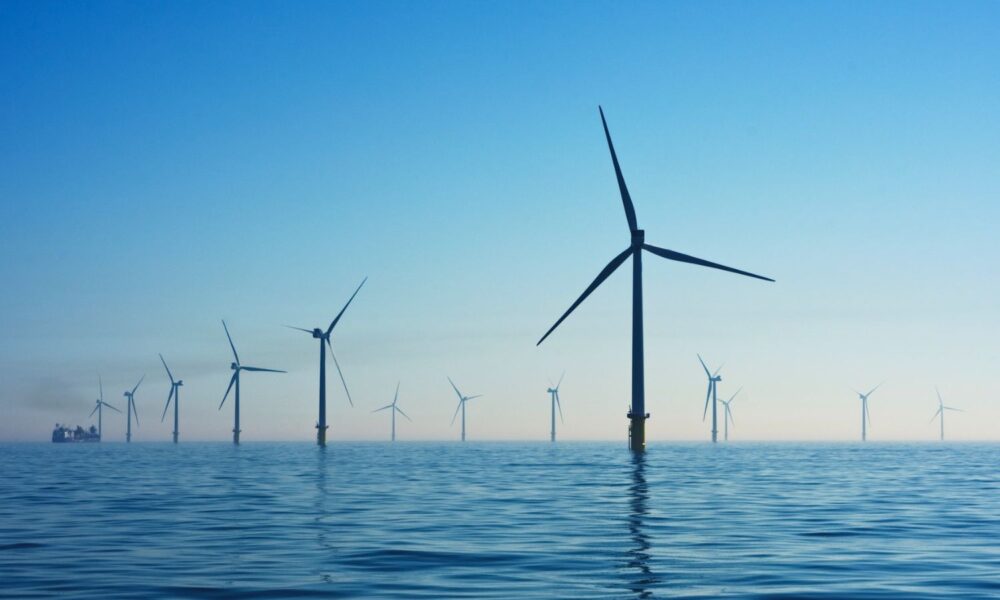A proposed offshore wind procurement bill in Maine would go a long way to enable the state to meet its climate and clean energy targets and become a national leader in floating offshore wind technology.
The newly updated legislation (LD 1895), which the legislature is considering this week, builds on recommendations from Maine’s Offshore Wind Roadmap and policies adopted by other leading states. It would require the Maine Public Utilities Commission (PUC) to conduct a competitive bidding process to procure 1,000 megawatts (MW) of offshore wind capacity by 2030 and 2,800 MW by 2035, enough to generate more than half of Maine’s electricity demand. Meeting these targets would strengthen Maine’s economy by creating high-quality jobs and helping stabilize energy costs. LD 1895 also would ensure that offshore wind is developed responsibly and equitably in the Gulf of Maine.
Here are five reasons why LD 1895 is so important for Maine:
Offshore wind is critical to achieve Maine’s climate and energy goals
Maine’s climate and clean energy laws are well-aligned with science-based targets for reducing heat-trapping emissions, and a recent Union of Concerned Scientists (UCS) report noted that Maine has one of the strongest climate action plans in New England.
That said, offshore wind development will be critical to meet state and regional climate and clean energy requirements. Recent studies project that offshore wind development in Maine could range from 500 MW to 1,000 MW in 2030 to 5,000 MW to 8,000 MW by 2050 (see reports by DNV, Evolved Energy Research, Synapse, E3 and Silkman).
With 2,800 MW installed and operating by 2040, offshore wind would provide more than half of Maine’s electricity demand, even if the state’s demand more than doubled as the state moves to replace fossil fuels with clean electricity for transportation and heating.
Procurement targets are an effective tool
More than two decades of adopting and implementing renewable electricity standards in 30 states shows that procurement targets have been a key driver for deploying land-based wind and solar, achieving economies of scale, increasing technology innovation, and lowering costs.
At least 10 other states, including six in the Northeast, have adopted offshore wind procurement targets totaling 81,000 MW over the next 20 years, according to the American Clean Power Association (ACP). These targets range from 1,400 MW by 2030 in Rhode Island to 11,000 MW by 2040 in New Jersey to 25,000 MW by 2045 in California. While LD 1895’s 2,800 MW by 2035 procurement target is more modest, most of the other states with higher targets have much larger populations and greater energy demand. Most states also have interim targets that ramp up over time, which gives the industry more investment certainty and will be necessary to build out the offshore wind supply chain.
Adopting a procurement requirement would give Maine a much better chance to compete in the race with other states to develop offshore wind and related supply chain infrastructure. According to ACP, more than 51,000 MW of offshore wind is currently under development in the United States, 84 percent of which is on the East Coast. This includes 938 MW currently under construction, 18 projects in advanced development representing 16,564 MW, and 18 projects in early development totaling 33,875 MW. While only a few floating offshore wind projects are currently operating globally, the development pipeline more than doubled over the past year from 91,000 MW from 120 projects to 185,000 MW from 230 projects.
Developing floating offshore wind projects in the Gulf of Maine will be important to meet state and regional targets and build on the University of Maine’s leadership in developing the technology. While floating offshore wind is more challenging to develop than fixed-bottom projects, the Gulf of Maine has the highest, most consistent wind speeds on the East Coast. According to the National Renewable Energy Laboratory (NREL), floating offshore wind represents 63 percent of the total technical potential for offshore wind in the North Atlantic and 65 percent at the national level.
Maine can capitalize on falling costs and federal incentives
Like land-based wind and solar photovoltaics, the cost of offshore wind is projected to fall rapidly over time as the technology matures and the supply chain grows. The cost of fixed-bottom offshore wind projects has already fallen by 48 percent, from $162 per megawatt-hour (MWh) in 2010 to $84/MWh in 2021, due to development in other countries.
While the costs of floating offshore wind projects are currently higher than fixed-bottom projects, they are projected to be similar by 2035. NREL and DNV expect floating offshore wind costs to dip to $60 to $80/MWh by 2030 and $45 to $50/MWh by 2035. The Biden administration, which set a goal of 15,000 MW of floating offshore wind by 2035, also has set a price target for floating offshore wind power at $45/MWh by 2035, which is less than the cost of electricity from new natural gas plants.
Incentives in the historic federal climate bill passed last fall will help lower the costs even further. In fact, the timing of Maine’s offshore wind procurement targets in LD 1895 is designed to take advantage of federal tax credits, which could lower the capital costs of projects built in the Gulf of Maine by at least 30 percent. Funding also is available to help build out Maine’s supply chain and offshore wind component manufacturing, spur investments in port infrastructure, and encourage transmission planning.
While the cost of offshore wind projects has increased in the past two years due to inflation, rising commodity prices, and supply chain pressures, UCS expects these effects to be temporary. Land-based wind similarly experienced temporary cost increases during the 2008 economic recession. But since 2009, the cost of land-based wind has dropped by more than two-thirds as inflationary pressures eased, the technology advanced, and the US-based supply chain matured.
Offshore wind can help stabilize energy costs
In addition to becoming increasingly cost-competitive over time, offshore wind also can help stabilize energy costs for households and businesses by reducing regional reliance on imported gas and oil. Dependence on gas for about half of the power generation in New England resulted in an 83-percent supply-rate increase in Maine last year, and a 49-percent supply-rate increase this year, representing a $32 jump in a typical household’s monthly electricity bill. Offshore wind power has no fuel costs, so power costs are more stable and predictable over time than fossil fuel-fired power. Wind also can help protect ratepayers from price volatility caused by such events as the Russian war in Ukraine or extreme weather. Moreover, offshore wind also would produce more electricity during the winter heating months when New England energy demand is greatest.
Offshore wind development resulting from LD 1895 also could put downward pressure on electricity and gas prices—and save ratepayers money. Electricity generation is dispatched at the regional level according to increasing costs. Since wind and solar have no fuel costs and low operating costs, utilities typically dispatch them first. Gas generators, on the other hand, have relatively high fuel and operating costs, so utilities typically dispatch them last to meet demand, thereby setting the market price of electricity. Thus, by reducing the need for more expensive gas generators that are on the margin, offshore wind could lower wholesale electricity prices.
- For example, a 2020 NREL study found that deploying 7,000 MW of offshore wind in grid operator ISO-New England’s (ISO-NE) transmission area would reduce regional wholesale electricity prices by 13 percent and result in total electricity production cost savings of as much as 18 percent.
- An analysis by ISO-NE that found that if 1,600 MW of offshore wind had been online during the 2018 cold snap, New England consumers would have saved more than $80 million, carbon dioxide emissions would have been 11 percent lower, and more reserves would have been available to maintain a stronger reliability margin.
Ensuring responsible, equitable offshore wind development
As someone who lives in a small coastal fishing community near Maine’s Acadia National Park, I can see up close the importance of developing offshore wind in a responsible and equitable way that includes strong labor and environmental standards and protections for the fishing industry, local communities, and tribes. The project labor agreements and labor “peace” agreements in LD 1895 are supported by the BlueGreen Alliance (of which UCS is a founding member) and have been adopted by other states to ensure offshore wind projects are built with strong labor standards and are able to maximize federal incentives available through the Inflation Reduction Act and infrastructure laws.
LD 1895 wisely includes tax incentives that would encourage wind development outside of Lobster Management Area 1 and offset the modest additional costs of locating projects further offshore. In addition, the bill would provide funding for local fishing communities, which would create new jobs and tax revenue, and for independent scientific research to determine the best way for Maine to embrace the vast benefits of wind power while protecting wildlife, fisheries and the environment.
LD 1895 also guarantees a place at the table for federally recognized and state acknowledged tribes and would require developers to consult with tribes every step of the way. Further, the bill includes workforce development, employment, and contracting opportunities, as well as financial and technical assistance to support robust monitoring of the fisheries that local tribes care about most.
While these provisions are a good start, more engagement with the tribes is clearly needed to avoid, minimize, and compensate for any negative impacts from offshore wind development. Tribal nations must be included in the development, permitting, and management of offshore wind projects. Likewise, more data and research is needed to ensure impacts to cultural resources are adequately considered in the US Bureau of Ocean Energy Management’s suitability analysis to identify potential offshore wind leasing areas.
Pass this bill!
It’s time to make offshore wind a reality in Maine, and LD 1895 offers a path forward for responsible and equitable development of this key resource. If you’re a Maine resident, you can tell your state senator or representative to support LD 1895 by clicking here.

